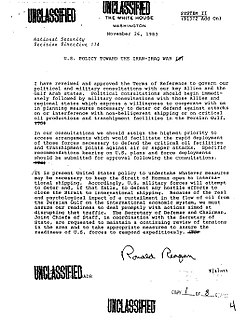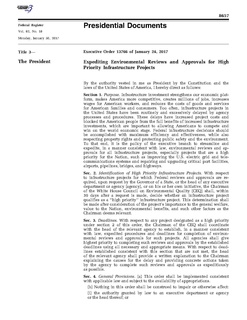
In the United States, an executive order is a directive by the president of the United States that manages operations of the federal government. The legal or constitutional basis for executive orders has multiple sources. Article Two of the United States Constitution gives presidents broad executive and enforcement authority to use their discretion to determine how to enforce the law or to otherwise manage the resources and staff of the executive branch. The ability to make such orders is also based on expressed or implied Acts of Congress that delegate to the president some degree of discretionary power. The vast majority of executive orders are proposed by federal agencies before being issued by the president.
Executive actions of the CIA are directives issued to the Central Intelligence Agency of the United States.

National security directives are presidential directives issued for the National Security Council (NSC). Starting with Harry Truman, every president since the founding of the National Security Council in 1947 has issued national security directives in one form or another, which have involved foreign, military and domestic policies. National security directives are generally highly classified and are available to the public only after "a great many years" have elapsed. Unlike executive orders, national security directives are usually directed only to the National Security Council and the most senior executive branch officials, and embody foreign and military policy-making guidance rather than specific instructions.
In the United States, a presidential commission is a special task force ordained by the president to complete a specific, special investigation or research. They are often quasi-judicial in nature; that is, they include public or in-camera hearings.
The powers of the president of the United States include those explicitly granted by Article II of the United States Constitution as well as those granted by Acts of Congress, implied powers, and also a great deal of soft power that is attached to the presidency.

The National Emergencies Act (NEA) is a United States federal law passed to end all previous national emergencies and to formalize the emergency powers of the President.
A presidential memorandum is a type of directive issued by the president of the United States to manage and govern the actions, practices, and policies of the various departments and agencies found under the executive branch of the United States government. It has the force of law and is usually used to delegate tasks, direct specific government agencies to do something, or to start a regulatory process. There are three types of presidential memoranda: presidential determination or presidential finding, memorandum of disapproval, and hortatory memorandum.

Executive Order 13766 is the second executive order signed by U.S. President Donald Trump. Signed on January 24, 2017, this order establishes a new system by which to fast-track the construction of infrastructure projects.

National Day of Patriotic Devotion, 2017 was the first Presidential proclamation signed by President Donald Trump.

Executive Order 13780, titled Protecting the Nation from Foreign Terrorist Entry into the United States, was an executive order signed by United States President Donald Trump on March 6, 2017. It placed limits on travel to the U.S. by nationals of several countries and barred entry for all refugees who did not possess either a visa or valid travel documents. This executive order—sometimes called "Travel Ban 2.0"—revoked and replaced Executive Order 13769 issued on January 27, 2017. Court rulings prohibited some of its key provisions from being enforced between March 15 and December 4, 2017. During its term of effect, it was revised by two presidential proclamations.
A presidential directive, or executive action, is a written or oral instruction or declaration issued by the president of the United States, which may draw upon the powers vested in the president by the U.S. Constitution, statutory law, or, in certain cases, congressional and judicial acquiescence. Such directives, which have been issued since the earliest days of the federal government, have become known by various names, and some have prescribed forms and purposes. Presidential directives remain in effect until they are revoked, which the president is free to do. The classification of presidential directives is not easily done, as the distinction between the types can be quite arbitrary, arising from convenience and bureaucratic evolution, and none are defined in the Constitution. Furthermore, the different types may overlap. As one legal scholar put it: "it is a bit misleading to overclassify presidential directives as comprising separate and distinct 'types' just because they have different headings at the top of the first page." In terms of legal applicability, what matters is the substance of the directive, not the form, unless a certain kind of directive is specifically required by relevant statute.

Ending Discriminatory Bans on Entry to The United States was the second presidential proclamation signed by President Joe Biden on January 20, 2021. The proclamation revoked Executive Order 13780, titled Protecting the Nation from Foreign Terrorist Entry into the United States, which had been signed by U.S. President Donald Trump on March 6, 2017, and Proclamations 9645, 9723, and 9983.











